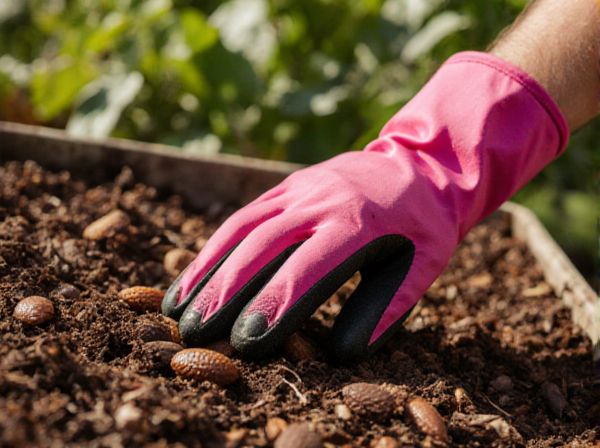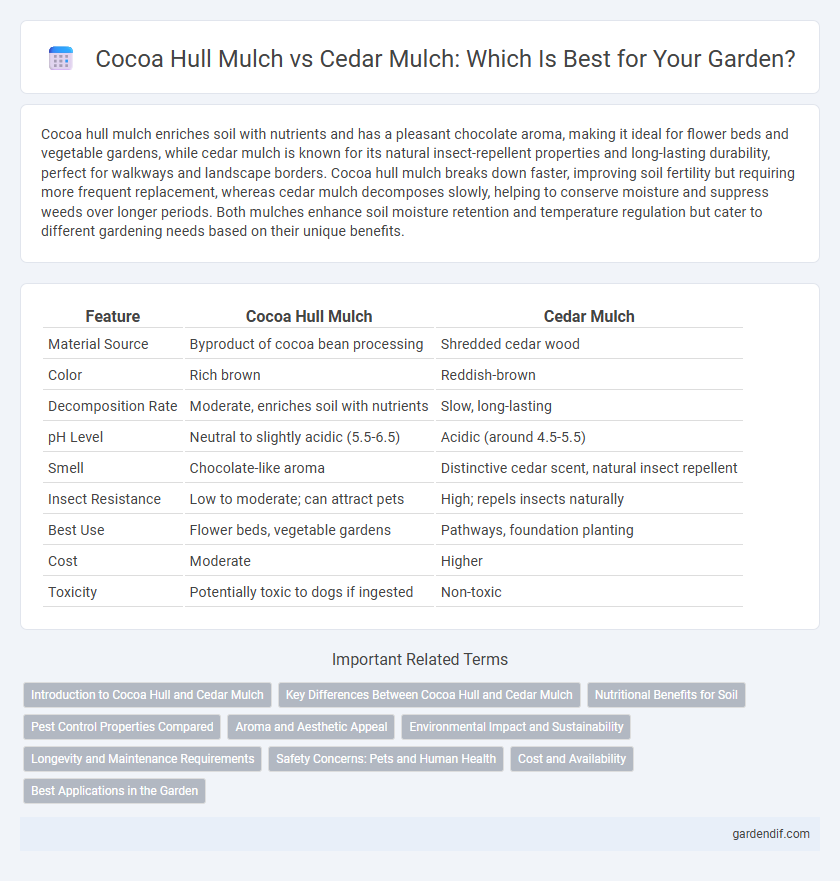
Cocoa hull mulch vs cedar mulch Illustration
Cocoa hull mulch enriches soil with nutrients and has a pleasant chocolate aroma, making it ideal for flower beds and vegetable gardens, while cedar mulch is known for its natural insect-repellent properties and long-lasting durability, perfect for walkways and landscape borders. Cocoa hull mulch breaks down faster, improving soil fertility but requiring more frequent replacement, whereas cedar mulch decomposes slowly, helping to conserve moisture and suppress weeds over longer periods. Both mulches enhance soil moisture retention and temperature regulation but cater to different gardening needs based on their unique benefits.
Table of Comparison
| Feature | Cocoa Hull Mulch | Cedar Mulch |
|---|---|---|
| Material Source | Byproduct of cocoa bean processing | Shredded cedar wood |
| Color | Rich brown | Reddish-brown |
| Decomposition Rate | Moderate, enriches soil with nutrients | Slow, long-lasting |
| pH Level | Neutral to slightly acidic (5.5-6.5) | Acidic (around 4.5-5.5) |
| Smell | Chocolate-like aroma | Distinctive cedar scent, natural insect repellent |
| Insect Resistance | Low to moderate; can attract pets | High; repels insects naturally |
| Best Use | Flower beds, vegetable gardens | Pathways, foundation planting |
| Cost | Moderate | Higher |
| Toxicity | Potentially toxic to dogs if ingested | Non-toxic |
Introduction to Cocoa Hull and Cedar Mulch
Cocoa hull mulch, derived from the shells of roasted cocoa beans, offers a rich, dark color and a pleasant chocolate aroma that enriches garden aesthetics. Cedar mulch, sourced from cedar trees, is prized for its natural insect-repellent properties and durability, making it ideal for long-lasting landscape coverage. Both mulches improve soil moisture retention and temperature regulation while enhancing the visual appeal of garden beds and pathways.
Key Differences Between Cocoa Hull and Cedar Mulch
Cocoa hull mulch is derived from the shells of cocoa beans, providing a rich, dark color and a pleasant chocolate aroma that attracts beneficial microbes, whereas cedar mulch is made from aromatic cedar wood, known for natural insect-repelling properties and long-lasting durability. Cocoa hull mulch decomposes faster and adds organic matter to soil, enhancing fertility, while cedar mulch breaks down slowly, maintaining landscape aesthetics for extended periods. Moisture retention is higher in cocoa hull mulch, promoting plant health, but cedar mulch offers superior resistance to mold and fungus growth.
Nutritional Benefits for Soil
Cocoa hull mulch enriches soil with essential nutrients such as nitrogen, potassium, and phosphorus, promoting healthy plant growth and improving soil fertility. Cedar mulch offers natural pest-repellent properties but provides minimal direct nutritional benefits to the soil. Using cocoa hull mulch enhances organic matter content and microbial activity, leading to better nutrient cycling compared to cedar mulch.
Pest Control Properties Compared
Cocoa hull mulch contains natural theobromine, which acts as a mild pesticide deterring insects like ants and mosquitoes, making it effective for pest control. Cedar mulch releases aromatic oils such as phenols and terpenes that repel a variety of common garden pests including fleas, ticks, and moths. While cocoa hull mulch enhances soil nutrition, cedar mulch excels in sustained pest deterrence due to its long-lasting aromatic compounds.
Aroma and Aesthetic Appeal
Cocoa hull mulch offers a rich, chocolate-like aroma that enhances garden sensory experience, while cedar mulch provides a fresh, woody scent known for repelling insects. Aesthetically, cocoa hull mulch features a deep brown color that darkens soil appearance, creating a lush, smooth finish, whereas cedar mulch presents a reddish hue with a coarse texture, adding rustic charm to landscape designs. Both mulches contribute distinct sensory and visual benefits, influencing garden ambiance and curb appeal.
Environmental Impact and Sustainability
Cocoa hull mulch biodegrades faster than cedar mulch, enriching soil nutrients while reducing landfill waste more effectively. Cedar mulch is naturally resistant to decay and pests, leading to longer mulch life and less frequent replacement but may involve forestry practices impacting ecosystems. Both mulches offer sustainable benefits, with cocoa hull mulch repurposing a byproduct of chocolate production and cedar mulch sourced from renewable timber, highlighting the importance of responsible sourcing and application.
Longevity and Maintenance Requirements
Cocoa hull mulch typically lasts around 6 to 9 months before needing replacement, while cedar mulch can endure 12 to 18 months due to its natural oils resisting decay. Maintenance for cocoa hull mulch involves monitoring for mold growth, especially in moist environments, whereas cedar mulch requires less frequent attention because of its insect-repellent properties. Both mulches improve soil health, but cedar mulch provides longer-lasting coverage with lower maintenance demands.
Safety Concerns: Pets and Human Health
Cocoa hull mulch contains theobromine, a compound toxic to dogs and cats, posing significant safety risks if ingested. Cedar mulch releases natural oils with insect-repellent properties but can cause skin irritation in sensitive individuals and respiratory issues in pets exposed to large quantities. Choosing mulch requires careful consideration of potential toxic effects on pets and humans to ensure a safe garden environment.
Cost and Availability
Cocoa hull mulch generally costs more than cedar mulch due to its nutrient-rich properties and limited regional availability, primarily sourced from cocoa processing plants. Cedar mulch is widely available across North America and is often more affordable, making it a popular choice for large landscaping projects. Availability fluctuations for cocoa hull mulch can increase prices seasonally, while cedar mulch remains consistently accessible in most garden centers.
Best Applications in the Garden
Cocoa hull mulch is ideal for flower beds and vegetable gardens due to its rich nutrient content and ability to improve soil texture, promoting healthy plant growth. Cedar mulch excels in pathways and around shrubs because of its natural insect-repellent properties and long-lasting durability in various weather conditions. Choosing between cocoa hull and cedar mulch depends on the need for soil enrichment versus pest control and sustainability in garden design.
Cocoa hull mulch vs cedar mulch Infographic

 gardendif.com
gardendif.com